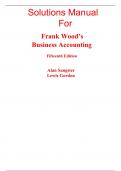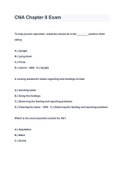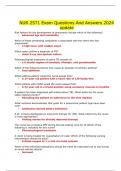Alan Sangster Lewis Gordon Solutions Manual For Frank Wood’s Business Accounting Fifteenth Edition 4 © 2021 Pearson Education Limi ted. All Rights Reserved. Contents Students and exam success 5 Answers 9 Accompanying Chapters* Chapter 29: Manuf acturing accounts Chapter 42: An int roduction to manag ement accounting *These two accompanying chapters can be downloaded as separate files with this Solutions Manual and are from the 14th edition of this book. Sangster and Gordon: Frank Wood’s Business Accounting , 15e, Instructor Solutions Manual 5 © 2021 Pearson Education Limi ted. All Rights Reserved. Students and exam success Experienced teachers and lectur ers know just as much as we do a bout this topic. There will, however, be people reading this who are new to teaching, and wh o have little experience in understanding how the examiner vi ews things. If we have anythin g to offer, it is simply that we have been involved in accounting education for decades and have both been examiners for several examining bodies. The Notes for Students at the start of Frank Wood’s Business Accounting deal with exam technique. Make sure your students read these. Go through these with them. If we all tell students that what these say is true, the n they are more likely to belie ve us. How students lose marks 1) Lack of knowledge (obviously) but they throw away marks unnecessarily for all of the following reasons: (a) Untidy work, including columns of figures not lined up. (b) Bad handwriting. Do not make it di fficult for the examiner to re ad and mark. (c) Lack of headings, dates, sub to tals, etc., in accounting statem ents. (d) Not submitting proper workings. You can only get them to rectify everything under this heading by insisting on them correcting (a), (b), (c) and (d) from early on in the course. D o not wait until a few weeks before the exam to insist upon pr operly laid out and neatly con structed work. 2) Students very often do not follo w the rubric on the exam paper. If it asks for two questions only from Section A, then it means just that. A remarkably high percentage do not follow the instructions per the rubric. 3) Students fail to answer the questions as set. If, for example, an examiner wants a list, students will lose marks by giving explanations instead. Students must tackle the question in the prescribed way and not do it differently. The percentage of stu dents passing exams would rise dramatically if only we could correct this failing. A good plan is to get them to highlight the instruction that shows how the examiner wants the question to be answered, for example, List the ways by which . . . Describe the ways by which . . . Write a report to the managing director ab out the ways by which . . . Discuss how the ways by which . . . Explain how the ways by which . . . Then, get them to underline the ke y words in the rest of the qu estion. They need as much practice as possible in doing this, especiall y for essay-type questions. Practice is even more essential for students for whom English i s not their first language. At the end of this section are 20 essay questions in which we h ave already highlighted the instruction and underlined the key words. See if your students can do the same. 4) Poor technique with essay questions. Business Accounting , Notes for students, the section headed ‘Answering essay questions’ covers this point. Discuss t his with your students who have to tackle essay questions. Sangster and Gordon: Frank Wood’s Business Accounting , 15e, Instructor Solutions Manual 6 © 2021 Pearson Education Limi ted. All Rights Reserved. 5) Not tackling the required number of questions. We have always f ound it very difficult to convince students to get hold of the idea that they will get mo re marks for five uncompleted questions than they will for four completed questions, when the examiner has asked for five to be attempted. Time planning is essential. 6) By not tackling the easiest questions first. Years ago, a lot of research was undertaken into the results of students who had followed this advice, compared with those who ignored it. Following the advice pr oduced better results. 7) By simply regurgitating the contents of a textbook in essay ans wers. For instance, when an examiner set a question on, say, materiality. Most of the answ ers simply gave exactly the same examples, word for word som etimes, that we have given in Business Accounting . Examiners are looking for originality and imagination. Students will get excellent marks if they give their own examples. A good idea is that, for each of the concepts and conventions, they think up their own examples before the exam. There are going to be more and more questions on these things in the years ahead. 8) Examiners like to see answers where students realise that all a ccounting is not found in textbooks, but exists for the use of businesses. Get them to us e examples in essay questions based on what they have observ ed in the businesses around them. For example, a question on ratio s and interpretation will often be answered by students just using figures. They should also say why the figures have changed; what possible causes there might have been. In their life outside their studies, they should observe how ac counting is carried out. They all go at one time or another to refectories, restaurants, shop s, department stores, clothes shops, travel on buses and trains, etc. They should observe how the money is calculated and collected, what sort of bills or tickets are given out, how fra ud or errors could occur and so on. They can give this flavour of the real world in their answer s. Believe me, they will get better marks. Sample essay questions w ith key words underlined 1) List the various pieces of informati on which should be shown on a sa les invoice. 2) Describe what is meant by an imprest system. 3) Accounting based on historical costs can be misleading. Discuss . 4) The bookkeeper has said that if a n error does not affect trial balance agreement then it cannot affect anything else very much. You are to write a report to the managing director stating whether or not you agree with the bookkeeper. 5) Give five examples of different compensating errors and explain why they cancel each other out. 6) Explain the differences between the str aight line and reducing balance methods of depreciation. 7) Briefly describe the benefits to be gained from maintaining control accounts. 8) List six instances of errors which c ould cause the trial balance tot als to disagree. 9) Name three methods of inventory valuation, and briefly describe any one of them. 10) ‘Without the use of accounting ratios, much of the accounting w ork already performed would be wasted.’ Discuss the amount of truth in this statement. 11) How can retail stores use accounting ratios to help them to plan fu ture inventory levels? 12) Assess the benefits of double entry as c ompared with single entry metho ds of bookkeeping.







